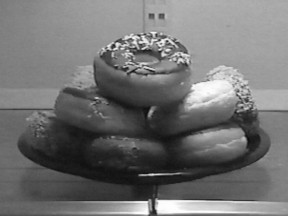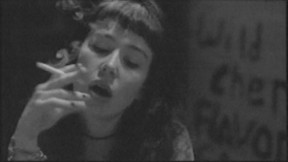 |
 |
 |
Video: It's not just cheap film Video's roots may be grounded in home movies and late-night infomercials, but the camcorder has started to take on its own artistic aesthetic, and there are indie video-makers everywhere using its cheapness as a valuable and creative tool. Meesoo Lee, a video-maker from Vancouver, whose work is inspired by zines and underground filmmaking, is one such artist. For his new video short, A Dream of Donuts, he used the video camera's tendency to bleed colours to create effective distinctions between segments of his movie. When actor Jeanette Ordas dreams she has a huge plate of donuts in the fridge, the video effect is nearly surreal in its colour saturation, while the real segments (when Jeanette awakes to discover the fridge is empty except for a jar of pickle brine) is shot with contrasting clarity. Like all of Lee’s shorts, the piece is perfectly timed. His use of surreal and spontaneous effects turn the mundane details of life into objects of fine art, and would not have made sense in any film-based medium other than video. "I started making videos because it was the only technology I could afford," Lee says about his choice of medium. "But you get to make lots of mistakes and try things out. And it's something you can do without taking classes."  In the space of a year, Lee has made four video compilations: Hair Fantasy & Other Delusions, Think, Why I Hate Modern Dance, and A Dream of Donuts. "I like the instant gratification," he says. "You get to see what you just made (for better or worse). And when you're finished editing you can run over to a friend's house and pop it into their VCR for an impromptu world premiere." There are limitations to the medium, for sure, particularly with old VHS camcorders. Quality degrades when the footage is edited, or enlarged for projection, and shots can easily slide out of focus, or end up being shaky. Many of the in-camera specials effects, like barn door wipes (the effect of doors closing) and page curls, are the height of cheese. But many video-makers have found uses for these weaknesses. Toronto video-maker and Broken Pencil's film and video reviewer, Johnathan Culp, uses older High-8 cameras to produce his on-the-fly activist video documentaries, including Chew It, Somalia!, Haywire and Other Hits, and Homeless on the Hill: OCAP Goes to Ottawa. "It's pretty easy to make a certain kind of video all by yourself," he says. "You can ignore lighting, use the in-camera microphone, run out onto the street and shoot whatever's going on." For example, Culp was filming on-the-fly at the Ontario Coalition Against Poverty’s (OCAP) June 15th riot on Queen’s Park. In Culp's view, the video camera is like a household appliance, "an image blender" he calls it. Camcorders are also quick to setup and easy to disguise, so they're perfect for under-cover shots. One of the great moments in feature-length video-making was in 1993 when a guy named Christopher Wilcha from Houston took a job as marketing assistant at Columbia House mail-order record club and took his camcorder to work each day. After a while, his co-workers forgot about his camera and let him film them in bizarre and revealing situations, such as getting a shot of customer service managers covertly monitoring the phone calls of their employees and the disorganized offices of the marketing department. Wilcha quit his job and went to film school where he edited the 2000-plus hours of footage into a documentary that exposes the uglier side of corporate America. Called The Target Shoots First (1999), the movie won two awards from the South By Southwest Film Conference and Festival (SXSW), including Best Documentary Feature and the Audience Award. Oddly, since completing the revelatory documentary, Wilcha has since been hired back by the marketing department of Columbia House. Incognito and impromptu don't necessarily mean sloppy. Esther Bell's feature-length movie Godass (2000), is a classic example of the kind of beauty digital video can produce. Based in New York, Bell formed her own production company, Hell's Bells, after she graduated from college. She started filming Godass on 16mm, a [superb] movie about a South Carolina punk zinester, Teri, whose mom keeps dating one loser after another. Teri doesn't fit in at all - she wears lots of black eyeliner and hosts punk rock shows to pay for printing her zine Skid Marks. Determined to bring her zine to a "more sympathetic" audience, she travels to New York with her two friends. While there, she stays with her biological father and comes to terms with her deep-sated homophobia while also managing to gain a bit of a reputation for her zine. 
What makes Godass so exciting is that it captures indie culture in a way Hollywood never could. Godass is a breakthrough in DIY media, and shot on a budget of just a few thousand dollars. Jason Kucsma of Clamor magazine remarked that Bell's use of digital video has "an aesthetic feel comparable to the high production quality that most people expect from major films." Not bad for low-end technology. The main difference between film and video seems to be that you don't have to wait for a producer to back your feature-length films. Is there a distinct video aesthetic? Johnathan Culp feels that if there is, it's primarily based on the medium's limitations. "Most video ends up on a television set rather than a big white wall, so you really kind of have to de-emphasize the panoramic vistas and dancing figures of light. You either need to blend in with your prospective surroundings, or create something so mind-blowing that it sucks everyone's attention right out of the room." The biggest obstacle for video-making is an effective distribution method - video stores don't often carry indies so their makers toil in relative obscurity. After making his political documentaries, Culp started a video distribution network, called Satan Macnuggit Popular Arts. He carries dozens of small activist and independent titles (including Meesoo Lee's videos), and distributes them through a zine catalogue where $5 videos can be bought through mail order. Culp has also managed to get Suspect Video to carry some of his titles. Culp thinks indie video might not stay underground forever. As he sees it, "When musical instruments became electric and affordable, the rock and roll that resulted was in general hugely energetic and truly popular, channeling old forms into an accessible and cathartic mutation. Don't pick your nose with your video camera, but don't try to ride it bareback to Hollywood either. Video was born to rock and roll!" For Meesoo Lee, e-mail: meesoo@direct.ca. For Johnathan Culp and Satan Macnuggit Popular Arts, e-mail: satanmacnuggit@tao.ca. Esther Bell’s Godass is available on line at her website (www.estherbell.com), or e-mail: estherbell@hotmail.com. Information about Christopher Wilcha’s The Target Shoots First is available all over the Internet. (Article reprinted from Lola magazine, Issue 8) EMILY POHL-WEARY is currently fixating on alternative media and the opponents of corporate domination. She co-wrote a book about the life of Judith Merril, a science fiction writer, anti-war activist and feminist. It will be published in March 2002 by Between The Lines. She is also co-editor of the zine Kiss Machine and managing editor of Broken Pencil magazine. She has also put her short video poems Balls, Because and Coffee online. |